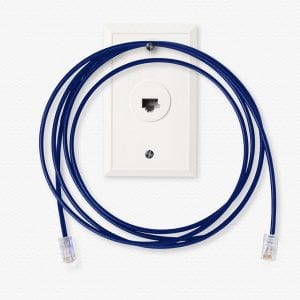Here we are! The new semester is almost here, and you’re gearing up for move-in. You have all of your furniture, your decor, those hand-me-down bath towels that mom wouldn’t let you leave the house without, and anything else you might need, right?
 On second thought, you remember hearing at AARO that there is one Ethernet port per bed in each residential commons. You also remember that not only do you have a PlayStation to connect, but also your Amazon Fire TV and your desktop computer. Sure, you could connect some of these devices to the PerunaNet wireless network, but you want the absurdly fast performance that only a wired connection can provide.
On second thought, you remember hearing at AARO that there is one Ethernet port per bed in each residential commons. You also remember that not only do you have a PlayStation to connect, but also your Amazon Fire TV and your desktop computer. Sure, you could connect some of these devices to the PerunaNet wireless network, but you want the absurdly fast performance that only a wired connection can provide.
If you’re wondering how to expand your wired network in your room, you’ll need a switch! What is a switch, exactly? It serves as an extension for a single Ethernet port so you can connect all of your devices. Switches (also known as hubs) are common, affordable, and easy to set up.
What About Routers?
When shopping for a switch, make sure that it is indeed just a switch/hub. The more attractively packaged and pricier devices are usually full-on routers, which provide more advanced capabilities and usually broadcast their own wireless network signals. Routers are not allowed to be connected to our network since we already provide those for you behind the scenes! Also, rogue wireless networks can compromise the overall security of the SMU network. If a wireless router is plugged into the SMU network, it will quickly be detected and disabled. When looking at a switch, make sure that it is an unmanaged or “dumb” switch.
Which Switch Should I Buy?
 Most basic 5-port switches are more than enough for most residents and their devices. 5-port Gigabit switches can be found for under $20. Some slower models can be less than $10! Once you move in, all you have to do is plug the switch into a power source and the Ethernet port by your bed.
Most basic 5-port switches are more than enough for most residents and their devices. 5-port Gigabit switches can be found for under $20. Some slower models can be less than $10! Once you move in, all you have to do is plug the switch into a power source and the Ethernet port by your bed.
I Got a Switch! What Now?
Now that you have your switch set up, make sure to register the devices you will plug into it. If you plug in an unregistered device, it will not function and could negatively affect the performance of the other devices plugged into the switch. If you have any questions or concerns about using a switch in your residential commons, let us know at help@smu.edu and we can point you in the right direction.


